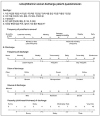Abstract
Purpose
To aid in the prosthesis care by comparing anophthalmic eyes with normal eyes in anophthalmic patients wearing prosthetic eyes for more than 1 year.
Methods
We retrospectively reviewed the medical records of 40 anophthalmic eyes and 40 normal fellow eyes of 40 patients who wore prosthetic eyes for more than 1 year after unilateral eye removal and orbital implant insertion. We compared data obtained from medical records on sex, age, punctal abnormality, lagophthalmos, eye discharge characteristics, tear meniscus height, upper eyelid palpebral conjunctiva, Meibomian gland dysfunction, Schirmer's test, lacrimal irrigation test, diagnostic probing, period of wearing the prosthetic eye, and frequency of prosthesis removal between anophthalmic eyes wearing a prosthesis and normal eyes.
Results
Anophthalmic eyes with lagophthalmos wearing a prosthesis had a higher frequency of eye discharge than eyes without lagophthalmos (p = 0.04). Eyes with frequent prosthesis removal had a higher frequency of eye discharge than eyes with less frequent prosthesis removal (p = 0.04). However, lagophthalmos and prosthesis removal frequency were not associated with tear meniscus height, or the results of Schirmer's test, or the lacrimal irrigation test (0.174 < p < 0.971).
Figures and Tables
 | Figure 1 |
Table 1
Discharge characteristics and frequency of prosthesis removal with anophthalmic eyes wearing prosthetic eye for more than a year

References
1. Pine K, Sloan B, Stewart J, Jacobs RJ. Concerns of anophthalmic patients wearing artificial eyes. Clin Exp Ophthalmol. 2011; 39:47–52.


2. Jang SY, Lee SY, Yoon JS. Meibomian gland dysfunction in longstanding prosthetic eye wearers. Br J Ophthalmol. 2013; 97:398–402.


3. Vardizer Y, Lang Y, Mourits MP, Briscoe MD. Favorable effects of lacrimal plugs in patients with an anophthalmic socket. Orbit. 2007; 26:263–266.


4. Saedon H, Cheung D. Occult traumatic nasolacrimal duct obstruction causing anophthalmic socket contraction presenting 20 years later: a case report. Cutan Ocul Toxicol. 2008; 27:87–89.


5. Kashkouli MB, Zolfaghari R, Es'haghi A, et al. Tear film, lacrimal drainage system, and eyelid findings in subjects with anophthalmic socket discharge. Am J Ophthalmol. 2016; 165:33–38.


6. Pine K, Sloan B, Stewart J, Jacobs RJ. A survey of prosthetic eye wearers to investigate mucoid discharge. Clin Ophthalmol. 2012; 6:707–713.
7. Kim JH, Lee MJ, Choung HK, et al. Conjunctival cytologic features in anophthalmic patients wearing an ocular prosthesis. Ophthalmic Plast Reconstr Surg. 2008; 24:290–295.


8. Chang WJ, Tse DT, Rosa RH, et al. Conjunctival cytology features of giant papillary conjunctivitis associated with ocular prostheses. Ophthalmic Plast Reconstr Surg. 2005; 21:39–45.


9. Osborn KL, Hettler D. A survey of recommendations on the care of ocular prostheses. Optometry. 2010; 81:142–145.


10. Pine KR, Sloan B, Stewart J, Jacobs RJ. The response of the anophthalmic socket to prosthetic eye wear. Clin Exp Optom. 2013; 96:388–393.


11. Kim DW, Kwon YA, Song SW, et al. Clinical usefulness of a thermal-massaging system for treatment of dry eye with meibomian gland dysfunction. J Korean Ophthalmol Soc. 2013; 54:1321–1326.

12. Garaszczuk IK, Mousavi M, Cervino Exposito A, et al. Evaluating tear clearance rate with optical coherence tomography. Cont Lens Anterior Eye. 2018; 41:54–59.


13. Lim KJ, Lee JH. Tear meniscus height in dry eye syndrome. J Korean Ophthalmol Soc. 1992; 33:29–31.
14. Vasquez RJ, Linberg JV. The anophthalmic socket and the prosthetic eye. A clinical and bacteriologic study. Ophthalmic Plast Reconstr Surg. 1989; 5:277–280.






 PDF
PDF ePub
ePub Citation
Citation Print
Print




 XML Download
XML Download